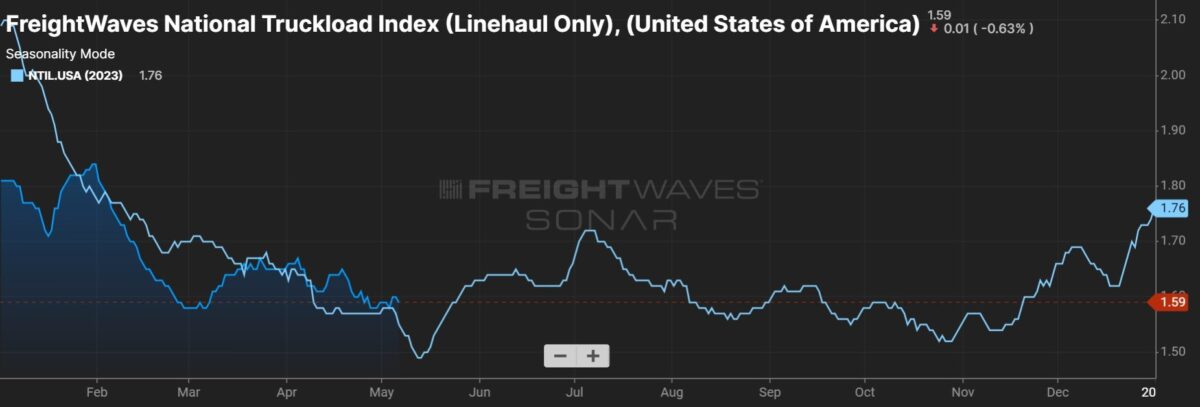Transportation metrics weakened in April, results from a monthly supply chain sentiment survey showed Tuesday. Following three straight months of expansion, freight rates slipped back into contraction territory, the report highlighted.
The transportation prices subindex (44.1 reading) fell 8.9 percentage points from March, with declining fuel prices presenting a modest drag on the data set. Transportation capacity (61.4) was up 1.8 points, remaining in “a robust rate of growth,” while utilization (56.4) was down just slightly.
The Logistics Managers’ Index (LMI) is a diffusion index. A reading above 50 indicates expansion while one below 50 signals contraction.
Prior reports showed “signs that the transportation market was moving back towards equilibrium,” but the latest update indicates “we are still firmly in a state of freight recession,” the report said.
Notable weakness was experienced in early April, when there was a 40-point spread between the transportation capacity subindex and the pricing data set. However, by the last two weeks of the month, the two readings were less than 3 points apart as prices increased more than 27 points (into growth territory at 54.8) while capacity declined 10 points to 57.4.
“This may be reflective of seasonal restocking of summer items, or increased hopes that interest rates could come down in late summer after reading the tea leaves of the most recent Federal Reserve meeting,” the report said.
Truckload carriers provided another sour update during the first-quarter earnings season as excess capacity has been slow to exit, pushing rates below operating costs for some fleets. However, Schneider National (NYSE: SNDR) pointed to a potential green shoot, revealing contract rate renewals were positive for the first time in six quarters.
“For us to be comfortable calling an end to the freight recession we would have to see several readings in a row in which prices grow faster than capacity,” the LMI report said. “While we inched close in late April, we are still some distance away from moving back into a boom period.”
While respondents expect transportation capacity to be modestly growing one year from now, returning a reading of 52, both utilization (68) and prices (73.8) are expected to see robust growth rates.
“Respondents are expecting the logistics industry to move back to a boom in the next 12 months,” the report continued. “That coming to pass may depend on whether the trends of late April continue into the rest of Q2.”

The overall LMI registered a 52.9 reading in April, down 5.4 points from March. While the overall index expanded for a fifth straight month, the April level was the slowest growth rate this year. The March reading was the highest in 18 months.
Inventory growth is slowing, weighing down the index.
Inventory levels (51) fell 12.8 points during the month, with a reading of 47.4 in the first half rising to 53.4 in the second. The report said the first-half weakness could have been tied to an expectation that interest rates may stay elevated, pointing to a neutral reading from upstream respondents (manufacturers and wholesalers), following March’s 64.8 reading.
“This suggests that manufacturers are keeping their powder dry until the interest rate picture becomes clearer — whether April’s more optimistic jobs report will impact this in any meaningful way remains to be seen,” the report said.
It also said the back-half acceleration in inventory levels could have been tied to the lingering effects of planning around Lunar New Year.
Inventory costs (68.5) increased 1.6 points from March and remained firmly in expansion mode. In addition to higher interest rates, warehouse prices (63.8) continue to keep the costs to store goods high.
The subindex for warehouse prices moved 2.5 points lower in the month as capacity (54) moved 9.4 points higher and utilization (55.1) fell 8.5 points. The changes in warehousing metrics align with logistics real estate operator Prologis’ (NYSE: PLD) first-quarter report, which included a slight reduction in the company’s 2024 guidance.
The LMI is a collaboration among Arizona State University, Colorado State University, Florida Atlantic University, Rutgers University and the University of Nevada, Reno, conducted in conjunction with the Council of Supply Chain Management Professionals.










